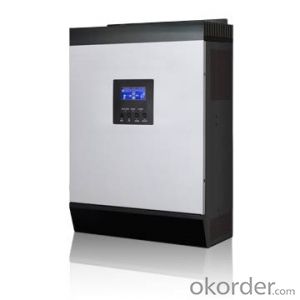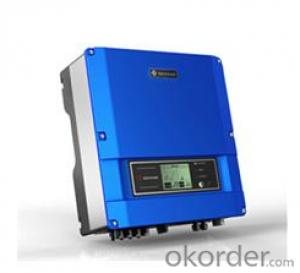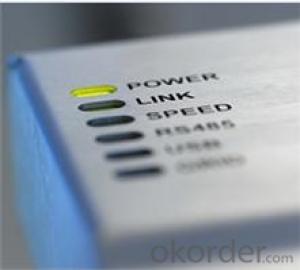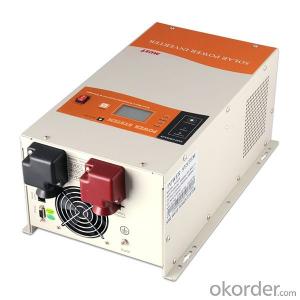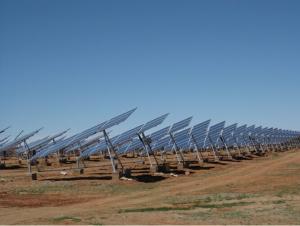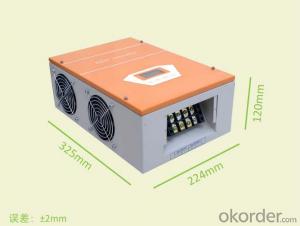2KVA/3KVA Inverter MPPT solar charge controller
- Loading Port:
- Shekou
- Payment Terms:
- TT OR LC
- Min Order Qty:
- 100 pc
- Supply Capability:
- 30000 pc/month
OKorder Service Pledge
OKorder Financial Service
You Might Also Like
Main Features
Pure sine wave inverter
Built-in MPPT solar charge controller
Selectable input voltage range for home appliances and personal computers
Selectable charging current based on applications
Configurable AC/Solar input priority via LCD setting
Compatible to mains voltage or generator power
Auto restart while AC is recovering
Overload and short circuit protection
Smart battery charger design for optimized battery performance
Cold start function
Rated Power 2000VA/1600W 2000VA/1600W 3000VA/2400W 3000VA/2400W
INPUT
Voltage 120 VAC or 230 VAC
Selectable Voltage Range 95-140 VAC or 170-280 VAC (For Personal Computers)
65-140 VAC or 90-280 VAC (For Home Appliances)
Frequency Range 50 Hz/60 Hz (Auto sensing)
OUTPUT
AC Voltage Regulation (Batt. Mode) 110/120 VAC ± 5% (User selectable) or 230VAC ± 5%
Surge Power 4000VA 6000VA
Efficiency (Peak) 90% - 93%
Transfer Time 10 ms (For Personal Computers)
20 ms (For Home Appliances)
Waveform Pure sine wave
BATTERY & AC CHARGER
Battery Voltage 24 VDC 48 VDC 24 VDC 48 VDC
Floating Charge Voltage 27 VDC 54 VDC 27 VDC 54 VDC
Overcharge Protection 31 VDC 62 VDC 31 VDC 62 VDC
Maximum Charge Current 20 A or 20 A / 30 A* 10 A or 10 A / 15 A* 20 A or 20 A / 30 A* 10 A or 10 A / 15 A*
SOLAR CHARGER
Maximum PV Array Power 1500 W 3000 W 1500 W 3000 W
MPPT Range @ Operating Voltage 30~ 115 VDC or 60 ~ 115 VDC 60 ~ 115 VDC 30~ 115 VDC or 60 ~ 115 VDC 60 ~ 115 VDC
Maximum PV Array Open Circuit
Voltage 145 VDC
Maximum Charging Current 60A
Maximum Efficiency 98%
Standby Power Consumption 2 W
PHYSICAL
Dimension, D x W x H (mm) 140 x 295 x 479
Net Weight (kgs) 11.5
OPERATING ENVIRONMENT
Humidity 5% to 95% Relative Humidity(Non-condensing)
Operating Temperature 0°C - 55°C
Storage Temperature -15°C - 60°C
- Q: How do you calculate the efficiency loss due to temperature for a solar inverter?
- To calculate the efficiency loss due to temperature for a solar inverter, you need to consider the temperature coefficient of the inverter. The temperature coefficient represents the percentage decrease in efficiency for every degree Celsius increase in temperature. By multiplying the temperature coefficient with the temperature difference from the inverter's rated temperature, you can estimate the efficiency loss. For example, if the temperature coefficient is 0.5% per degree Celsius and the temperature increase is 10 degrees Celsius, the efficiency loss would be 5%.
- Q: Can a solar inverter be used with solar-powered greenhouse systems?
- Yes, a solar inverter can be used with solar-powered greenhouse systems. A solar inverter is an essential component in converting the direct current (DC) generated by solar panels into alternating current (AC) that can be used to power electrical devices. By installing a solar inverter, the solar energy collected by the greenhouse's solar panels can be efficiently converted and utilized to power various equipment and systems within the greenhouse, ensuring an environmentally friendly and sustainable energy source.
- Q: Can a solar inverter be used in areas with high levels of electromagnetic interference (EMI)?
- Yes, a solar inverter can be used in areas with high levels of electromagnetic interference (EMI) as long as the inverter is designed and tested to withstand such conditions. Inverters with robust shielding and advanced filtering mechanisms can effectively mitigate the effects of EMI, ensuring stable and reliable operation even in challenging electromagnetic environments.
- Q: Can a solar inverter be used with different types of solar panels (monocrystalline, polycrystalline, thin-film)?
- Yes, a solar inverter can be used with different types of solar panels such as monocrystalline, polycrystalline, and thin-film. Solar inverters are designed to convert the direct current (DC) electricity generated by solar panels into alternating current (AC) electricity that can be used to power household appliances and feed into the grid. As long as the solar panel's output voltage and current fall within the operating range of the inverter, it can be used regardless of the panel type.
- Q: Can a solar inverter be used in systems with different module efficiencies?
- Yes, a solar inverter can be used in systems with different module efficiencies. Solar inverters are designed to convert the DC power generated by solar panels into AC power, regardless of the module efficiency. The inverter's main function is to optimize the power conversion process and ensure compatibility between the solar panels and the electrical grid. As a result, it can accommodate varying module efficiencies and still function efficiently.
- Q: How does a solar inverter protect against lightning strikes?
- A solar inverter typically has built-in protective measures, such as surge protection devices and grounding systems, that help safeguard against lightning strikes. These protective measures divert the high voltage surge caused by lightning away from the inverter, ensuring its safety and preventing damage to the solar power system.
- Q: How does a solar inverter handle voltage sag and swell?
- A solar inverter handles voltage sag and swell by continuously monitoring the input voltage from the solar panels and adjusting its output voltage accordingly. In the case of voltage sag, when the input voltage drops below a certain threshold, the inverter boosts the voltage to maintain a stable output. Similarly, in the case of voltage swell, when the input voltage exceeds a certain limit, the inverter reduces the voltage to prevent any damage to the connected devices. This process ensures that the solar inverter consistently provides a steady and safe electrical supply.
- Q: Can a solar inverter be used off-grid?
- Yes, a solar inverter can be used off-grid. Off-grid solar systems typically include batteries to store excess energy generated by the solar panels. The solar inverter converts the direct current (DC) power from the solar panels into alternating current (AC) power, which can be used to power household appliances and devices. This allows for the use of solar energy even when there is no access to the main electricity grid.
- Q: How do you calculate the maximum power point voltage for a solar inverter?
- To calculate the maximum power point voltage for a solar inverter, you need to determine the voltage at which the solar panels generate the maximum power output. This is done by varying the load resistance and measuring the corresponding power output. The maximum power point voltage is the voltage at which the power output is highest.
- Q: What is the maximum input voltage that a solar inverter can handle?
- The maximum input voltage that a solar inverter can handle varies depending on the specific model and manufacturer. However, in general, most solar inverters can handle input voltages in the range of 600 to 1000 volts DC.
Send your message to us
2KVA/3KVA Inverter MPPT solar charge controller
- Loading Port:
- Shekou
- Payment Terms:
- TT OR LC
- Min Order Qty:
- 100 pc
- Supply Capability:
- 30000 pc/month
OKorder Service Pledge
OKorder Financial Service
Similar products
Hot products
Hot Searches
Related keywords

